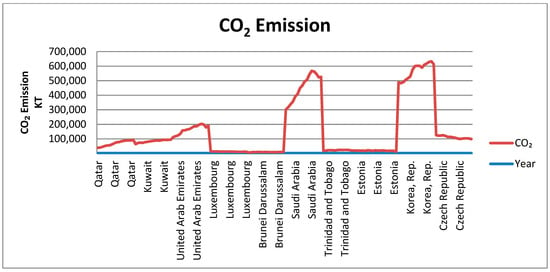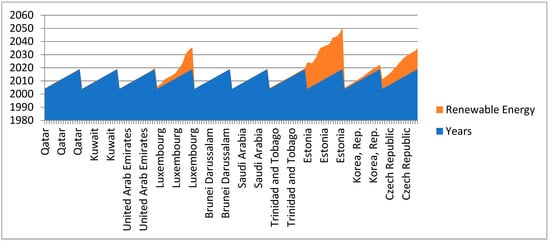Scholars have carefully studied all variables that directly or indirectly preserve environmental protection. For instance, ref. [
4] observed that deteriorating environmental prominence threatens human existence due to GDP, economic decentralization, globalization, innovation, and technology. Fuel-efficient technology might reduce global carbon emissions [
5]. Eco-friendly goods and techniques, infrastructure modernization, capturing and conserving carbon, electricity production, sustainable power, and eco-friendly grid operations and power conservation have major environmental impacts [
6]. Another school of research has examined aspects including industrial production, technical progress, natural resources, and human resources [
7], whereas the latest research has proven the importance of financial growth and monetary inclusion [
8] (see for example [
8] or [
9]).
Technological advances have spread worldwide in the 21st century. Global and regional collaboration and coordination efforts are overlapping geographical boundaries, offering a glimpse of win–win commerce, prosperity, and coordination. The rise of global temperature and worsening climate conditions affect even the developing nations despite their negligible share of these industrial waste productions [
3]; however, technological influences and green energy usage can ultimately reduce CO
2 emissions creating hope for things to improve. Scholars want to know how these contributing factors impact both developed and developing nations in various areas in the short and long term [
10]. One belt one road (OBOR) is a potential worldwide regional cooperation and coordination initiative. Globalization, economic growth, financial inclusion, renewable energy, and technological advances in communication and information affect short-term and long-term CO
2 emissions for the top 10 CO
2 emitters under the One Belt One Road consortia. The One Belt, One Road (OBOR) initiative, launched by China in 2013, is the largest major initiative by a single country and can dramatically impact global markets and development. The proposed project includes over two-thirds of the world’s population, one-third of the global GDP, and 25% of worldwide commerce. It has two primary parts: The Belt, or new Silk Road, is a land-based initiative including ports, shipping lanes, and marine development linking China’s east coast to south Asia and Europe across the Indian Ocean. Ports, trade channels, and marine infrastructure link Inner China to Europe via Central Asia and the Middle East [
11].
2. CO2 Emission
Emissions of CO
2, which make up the majority of greenhouse gases, significantly contribute to global warming leading to catastrophic impacts on life on the planet. CO
2 emissions have increased by 31.79% between the period of 2003 and 2018 and account for 72% of emitted greenhouse gases [
18,
19], forcing many nations to set reduction targets for carbon emissions.
The relative share of carbon emissions is 3.6% for South and Central America, 3.8% for the African region, 6.2% for the Middle Eastern countries, 6.3% for the Commonwealth of Independent States, 11.2% for the European countries, 16.5% for the North American region, and 52.3% for the Asia Pacific region. During the last decade, South and North American countries and European nations were able to reduce emissions by 1.2, 0.1, and 1.9% respectively due to their effective strategies [
20].
After extensively reviewing the literature, the researchers tried to combine the most prominent causes of carbon emissions in a single study that includes financial inclusion, renewable energy, globalization, and economic growth. Additionally, a graph is provided in Figure 2 to help understand the CO2 emissions in the top 10 OBOR nations. It shows that the Czech Republic had the greatest CO2 emissions at the beginning of the examination period and that they then began to decline. The trend is consistent in Luxembourg.
Figure 2. Top 10 emitter OBOR Countries CO2 Emission.
3. Financial Inclusion
One of the credible definitions of financial inclusion states “financial inclusion means that individuals and businesses have access to useful and affordable financial products and services that meet their needs–transactions, payments, savings, credit, and insurance–delivered in a responsible and sustainable way” [
8]. Financial inclusion represents the economic stability of a country; however, high economic activity leads to high energy consumption which negatively affects the environmental quality through the emission of carbon dioxide.
Before the introduction of financial inclusion and carbon emissions, financial stability or financial instability has been studied with carbon emissions or with environmental quality [
23,
24,
25,
26,
27]. Financial inclusion is a more appropriate measure as compared to financial stability since financial inclusion is achieved after financial stability and it is an overarching concept that truly reflects the financial health of a country’s businesses and individuals by measuring the ratio or percentage of the population having access to financial products/services [
9,
28].
Some studies claim that financial inclusion decreases carbon emissions [
29]; however, from the data collection of 31 countries by Le [
30] financial inclusion came out to be the most important contributor of carbon emissions as compared to the other four contributing factors. These findings strongly suggest probing the relationship between financial inclusion and carbon emissions. Financial inclusion has been previously measured in terms of bank accounts per 1000 adults [
31,
32], percentage of bank credit to bank deposits [
32], percentage of life insurance premium volume to GDP [
33], and percentage of non-life premiums to GDP [
34].
4. Economic Growth
Economic growth requires energy, and to the extent that this energy is produced using fossil fuels, it results in carbon emissions. A crucial topic for climate change is the nature of this connection between the expansion in economic activity and carbon emissions. The quest to increase economic activity without an increase in carbon emissions is a global challenge. There are parts of the world that also demonstrate an inverse relationship between economic growth and carbon emissions due to which there does not appear to be a widespread consensus among researchers on this relationship. The studies that have concluded a positive relationship between economic growth or energy consumption with carbon emissions include the work of Ehigiamusoe and Lean [
35], Mensah et al. [
36], and Musah et al. [
37].
The studies with an inverse relationship between economic activity and carbon emissions include the work of Sun et al. [
38] and Ozcan [
39]. A group of academics have asserted a link between CO
2 emissions and economic development, claiming that CO
2 emissions rise during the early phases of economic development but fall after a particular level of economic development is reached [
40,
41,
42].
These contradicting results could also be the consequence of differences in time and place. Mensah et al. [
39] focused on African economies, Musah et al. [
37] selected West Africa, Ozcan [
39] selected Middle Eastern countries, Sun et al. [
38] worked on China and Xu et al. [
42] focused their study on G20 countries. There are still many regions of the planet that are not covered, indicating an ongoing discussion on the relationship between economic activity and carbon emissions and the requirement for additional research.
5. Renewable Energy
Renewable energy in the form of wind, solar, and water is taken very seriously as a source of reducing carbon emissions. The use of renewable energy has been studied in various studies for the reduction in carbon emissions and improvement in the air quality for developing nations [
43,
44,
45,
46,
47,
48] and as well as for developed nations [
37,
38,
39] or for both of them [
40,
41].
Various techniques have been used to establish the relationship between renewable energy and carbon emissions including panel pooled mean group-autoregressive distributive lag model [
39], modified ordinary least squares and vector error correction [
42], and the AMG approach [
43]. The findings of these techniques and research work complement each other, and in most of the literature renewable energy is claimed to have mitigated carbon emissions. Furthermore, the renewable energy trend is provided in the top 10 OBOR countries below in
Figure 3.
Figure 3. Top 10 emitter OBOR Countries Renewable Energy.
6. Globalization
Increased cross-border trade in products and services, increased international money flows, and increased labor flows are all signs of globalization, the ongoing process of greater economic interdependence among nations [
44]. Several studies have attempted to study the impact of globalization on CO
2 emissions and environmental quality. In their investigation of 40 developed and developing nations, Antweiler et al. [
45] found that trade liberalization enhances environmental quality. According to research conducted by Sinha and Shahbaz [
46] for India between 1971 and 2015, trade is negatively related to carbon dioxide emissions. Acheampong [
47] showed how decreased global carbon emissions resulted from trade openness and improved environmental quality.
Although there is a consensus that globalization reduces carbon emissions and improves environmental quality, the relative impact of this relationship is varied across the globe. This was concluded in the research conducted by Shahbaz et al. [
48] in which a general trend showed a reduction in carbon emissions due to globalization but with varying effects from country to country in the African region. Trade liberalization decreases carbon dioxide and sulfur dioxide pollutant emissions in OECD countries while increasing emissions in non-OECD countries [
49].
Chang et al. [
50] attributed the varying effect to the income level of an economy. They concluded that trade liberalization only improved environmental quality in high-income countries while increasing carbon emissions in low-income economies. An improved understanding of this phenomenon is the result of the study by Shahbaz et al. [
51] that concluded a bidirectional relationship for middle-income counties between trade and carbon emissions and a unidirectional one for high-income and low-income level countries. Another explanation of the varying effect is provided by Farhani et al. [
52], who claimed that trade liberalization’s impact on environmental quality is based on the scale of trade growth, the techniques shared for environmentally friendly technologies, and the techniques of production employed by the host country. These results open avenues for research in upcoming global regions, alliances, and partnerships that believe in trade liberalization and lifting hurdles that hamper globalization.
7. Information and Communication Technology
Information and communication technologies (ICTs) have been shown to have a wide range of effects on important global mechanisms. Prior studies have documented the impact of ICT on different environmental and development aspects. ICT has been studied for economic prosperity and development [
53,
54], sustainable development [
55,
56], and alongside carbon emissions [
57,
58]. It has been documented that these technologies increase productivity, lower energy intensity, and may even facilitate production of cheaper renewable energy. Each one of these effects has different implications for CO
2 emissions, causing a lack of agreement on how ICTs will affect carbon emissions [
59,
60].
Some advocate the use of ICT as a strategy to slow down the effects of climate change by enhancing energy efficiency [
61,
62] and lowering the price of renewable energy sources [
63]. Other studies support the significant link between ICT development and economic expansion [
64,
65,
66] which would raise energy consumption and carbon dioxide emissions.
There are different results of ICT on environmental quality in different parts of the world. ICT has been proven to reduce environmental damage and carbon emissions in the BRICS region [
67], Pakistan [
68], and China [
69]. ICT has been associated with increased carbon emissions in sub-Saharan African countries [
70]. Comparative studies conclude that ICT increases carbon emissions in low-income countries while the opposite is true for middle and high-income countries [
71]. Finally, the studies by Higón et al. [
72] and Faisal et al. [
73] claim that ICT increases pollution up to a certain level and eventually reduces it later on. Hence, a generally agreed-upon finding on the overall effect of ICTs on the environment has not yet been achieved.


 Encyclopedia
Encyclopedia
